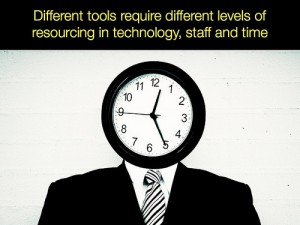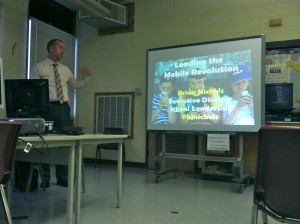
I left Educon 2.4 with questions. I think that’s the point. For every new “a-ha” moment, a handful of extending questions surfaced in my brain. Some energized me, some exhausted me.
“What if?” This was the first question I was asked to ponder at Educon. David Jakes led a session that caused us to truly expound on our thinking about topics ranging from hallways in our schools to shopping cart design. Design Thinking for Educators is a resource that I’ve referenced in the past but would like to explore in depth. I see tremendous power in this process, yet could also see how many of us were extended past our comfort levels in thinking about change. Our experiences tell us that the ideation process should typically have limits. The design thinking process says, “No, it doesn’t.” We need to start asking, “What if?”
“Social media-fueled PD: is it making a difference?” Lots of chatter here. Jon Becker, Meredith Stewart, and Bud Hunt asked us to consider whether the time we spend engaged in learning through Twitter and unconventional methods. The #edchat and #edcamp folks amassed in this session, I believe, to stand firm and defend their methods of learning through social media. I don’t think the facilitators questioned the value we find in these methods so much as they wished for us to consider how we would defend the impact of this learning to parents, administrators, etc. A few months ago a conversation on Twitter emerged about how we measure the effectiveness of this PD. What actual difference is it making in our schools? How is that impact measured? And should it be? My take-away comment from this session came from Shelly Blake-Plock, who essentially declared that this type of learning “ruined his life,” in so much as it turned his life upside down; changed his way of thinking; caused him to relocate, change jobs, and devote himself to working with at-risk students. I’d imagine his students are quite thankful for this transformation.
“How do we ask the right questions?” Zac Chase’s session asked us to consider our inquiry-based practices in schools. What questions are we asked our students? Teachers? Why? He opened with a story about a young boy and his mother in the airport. The mother seeking to keep her son distracted from through a proposed “game” involving the arrivals/departure board; the son asking to change the “rules” of the game in order to better meet his needs. So when we allow the learner to change the rules- if it gets us to the same goal, does it matter? Perhaps more importantly, are the questions we’re asking leading to the right goals?
“So you’re connected… now what?” Team Couros & Larkin again hosted a session to discuss the administrator’s role in propelling learning organizations forward through immersion with connected learning. This follow-up session also sought to define and describe real ways in which connected learning are influencing students. Not surprising, the topics of administrative fear, apprehension, and skepticism were raised. Many administrators are still uncomfortable with the ideas of connecting themselves, their teachers, and their students. Are you an administrator? Or do you know one? Send them to Connected Principals. Get them connected with one of us. It starts with tough conversations, but it has to start somewhere.
“How can we rethink learning spaces?” Michael Wacker and Glenn Moses kicked off their conversation by asking us to consider, “What is the most meaningful PD you’ve ever had?” Many mentioned Twitter (I stand in my position that Twitter in itself is not PD – the conversations and connections with other learners through that vehicle could constitute development, but Twitter is merely a tool), #edcamps, and the like. I remember when I taught 5th grade, one of my colleagues ran a PD session as a requirement for one of her master’s courses. It was the first time information was formally presented to me by a colleague. As I think back on that now, I found that session to be very engaging and informative, and I believe it was that much more meaningful since the ideas being shared were from someone I worked with on a daily basis. It was personal and real, as all PD should be, no matter if the learning space is physical or virtual.
Elemeducon. I proposed my conversation because in past years, I felt there hasn’t been much of an elementary focus in the conversations at Educon. I think that’s now changing, as there were several sessions this year with an elementary focus. My hope is that we can continue the discussion raised in our energizing elementary innovation session on the final day of the event. We asked a lot of questions. I’m working on a separate space to share our thoughts from the session, to create a place where the many passionate elementary educators in our world can share ideas and support one another through this journey.
Do you have ideas for what you would like to see in this space? Format? Must-haves? Essential components? I’d love to hear your thoughts. Stay tuned!












